ChatGPT for SEO: 8 Experts Share How to Use ChatGPT for SEO Tasks
Ever since its launch, ChatGPT has been grabbing headlines in all forms of media. And rightly so!
It has managed to attract millions of users right from its first month of launch. ChatGPT is proving to be a significant breakthrough in AI, and it has already started making its space in multiple industries.
Now, the question is: How can you use it for SEO?
We asked some of the best SEOs globally to find out how (and if) they’re using ChatGPT for SEO tasks. And we found out there are plenty of use cases of this tool that can help you automate some of the mundane SEO tasks.
But before we jump into the SEO use cases of ChatGPT, let’s cover some basics.
What is ChatGPT?
ChatGPT is an AI language model developed by OpenAI. It is designed to respond to text-based input and generate natural language (human-like) responses. It is trained on a massive corpus of text from the internet, which allows it to generate responses on a wide variety of topics.
This tool can answer your questions and also assist you in multiple tasks like writing essays, emails, creatives, codes, and much more.
ChatGPT was released on 30th November 2022 and since then it has been well-received by many industries including digital marketing and SEO.
As mentioned earlier, millions of users started using ChatGPT right from its first month. And the user base grew beyond what the ChatGPT team anticipated and what its infrastructure could support. This started causing frequent server overloads and users being unable to access the service.
Building on the free tool’s massive success, in February 2023, they announced ChatGPT plus — a premium plan for a $20/month subscription that would:
- Allow users to access ChatGPT, even during peak times
- Provide faster response to queries
- Give priority access to new features and improvements
Meanwhile, OpenAI was already working on the GPT-4 language model (the successor of GPT-3.5) and launched it on 14th March 2023. For now, GPT-4 is only available to ChatGPT Plus subscribers and approved developers on the API waitlist.
GPT-3.5 vs GPT-4: What’s the Difference?
OpenAI spent six months making GPT-4 safer, more aligned, and significantly advanced as compared to GPT-3.5. As OpenAI claims, GPT-4 is 82% less likely to respond to disallowed (or illegal) content and 40% more capable to produce factual responses than GPT-3.5.
Here’s a comparison table for the technical features of GPT-3.5 and GPT-4.
| Feature | GPT-3.5 | GPT-4 |
| Architecture | Transformer-based architecture with 175 billion parameters | Transformer-based architecture with approximately 10 trillion parameters |
| Parameter size | 175 billion | 10 trillion approximately |
| Language model | Capable of Natural Language Processing (NLP) and generation | More advanced and accurate Natural Language Processing (NLP) and generation |
| Performance | State-of-the-art performance in various NLP tasks | Upgraded performance than GPT-3.5 —especially in complex language tasks |
| Dataset | Trained on a large dataset of internet text | Trained on an even larger and diverse dataset |
| Use cases | Text completion, language translation, chatbots, and more | Expands on current use cases and enables new ones |
Besides, GPT-4 is:
- More creative and collaborative: GPT-4 is capable of creating, editing, and collaborating with users on various creative and technical writing tasks like crafting music lyrics, screenplays, and adapting to the user’s writing style.
- Able to accept visual inputs: You can also insert images along with text prompts to interpret data, generate analysis, write captions, etc.
- Capable of handling longer and complex prompts: GPT-4 can handle much lengthier prompts — over 25,000 words. Hence, it can be helpful for use cases like long-form content creation, research & analysis, document search, etc.
How will ChatGPT Impact SEO?
Just like any competent tool helps you improve and accelerate your processes, ChatGPT too has multiple SEO use cases to improve SEO productivity.
To start with, ChatGPT has shown its potential to take care of some of the mundane and routine SEO tasks like sorting data, writing meta descriptions, determining FAQs, etc. Besides, there are plenty of other use cases that we’ve covered in the later section.

“Will ChatGPT have a big impact on SEO? – absolutely. It’s already impacting it and we’re just at the tip of the iceberg. But any time a technology rushes Google to dramatically change the SERPs, you can bet that it’s going to affect SEO.”
Going forward, we’ll also see how the overall search experience evolves once ChatGPT and other generative AI tools are integrated into search engines.
According to a recent study, 25.6% of Desktop searches and 17.3% of Mobile searches result in zero clicks — users get their answers directly on SERPs without clicking on a link. With these generative AI tools being synced with search engines, the number of zero-click searches may rise.

I think ChatGPT and other AI will have an impact on SEO. The introduction of AI answers into their SERPs will eat into the available organic real estate, by increasing the number of zero-click searches and overall reducing the amount of traffic that lands on websites.
What are the Limitations of ChatGPT?
Sure, ChatGPT is a remarkable breakthrough in the AI landscape by using the deep learning model to generate human-like responses. This makes it a popular tool for chatbots and conversational agents.
However, just like any technology, ChatGPT has its fair share of limitations that you need to consider. Here are some limitations that OpenAI has highlighted on its website.

That said, let’s address some of the main challenges of ChatGPT.
Hallucinations
As OpenAI mentions: “ChatGPT sometimes writes plausible-sounding but incorrect or nonsensical answers”. This is a major concern.
As a language model, ChatGPT is designed to generate responses based on patterns and associations it has learned from vast amounts of data. However, it can sometimes generate responses that don’t align with reality, leading to what is called a “hallucination.”
These inaccuracies can sometimes have severe consequences — especially in YMYL (Your Money Your Life) niches like healthcare, finance, and legal.

“The largest risk of ChatGPT is that the answers are highly unreliable at this point, especially if the prompt is short. Any output requires human review and confirmation. If this is not done, you run the risk of lacking the appropriate E-E-A-T required for content to perform well. Nevertheless, utility content (product descriptions, glossary pages, contact pages, etc.) has less risk—and, usually, competition—than thought leadership content.”
Although GPT-4 has reduced the hallucination occurrences significantly, the issue still persists. So, OpenAI suggests being careful while using the language model outputs.
Token Limit
Owing to token limits, ChatGPT can only generate responses of a certain length. For instance, the GPT-3.5 model can deliver requests up to 4096 tokens (3000 words) — including the length of the prompt.
This means if your prompt length is 1000 words, the maximum length of the output would be 2000 words. This limitation can impact the quality of responses generated, particularly when responding to complex or lengthy prompts.
Besides, this model can only remember up to 3000 words of information in the current conversation. So if you’ve generated lengthier conversations in parts, it won’t remember the entire data.
As a result, the token limit also impacts the model’s ability to provide detailed or comprehensive responses, which can be a challenge in creating long-form content assets.
OpenAI has addressed this challenge in the GPT-4 language model and it can process requests up to 32,000 tokens. However, GPT-4 is only available on premium plan.
Possibility of Outdated Data
ChatGPT is trained on the data that was available up until September 2021 — any new data, trends or innovations after that aren’t incorporated into the model.

“Using AI-generated content risks committing plagiarism, posting low-quality writing, and spreading outdated information. We mitigate these by scrutinising everything ChatGPT produces and enhancing the copy before posting it.”
So while the tool can still provide accurate responses based on the data it has learned, it may not be up to date on the latest information. This is particularly relevant in fields such as science and technology, where new discoveries and breakthroughs happen regularly.
While ChatGPT is an impressive and powerful tool, you also need to consider the above limitations when using it. With that, let’s learn how you can leverage it for your SEO tasks.
How to Use ChatGPT for SEO Tasks?
Here are some of the ways you can use ChatGPT for your daily SEO tasks.
1. Keywords Suggestions
Keyword research is one of the foundational activities in SEO. Although you can’t use ChatGPT for keyword research (thorough end-to-end keyword research), it can certainly help you with basic research such as finding keyword ideas.
For instance, you’re running an affiliate blog on eCommerce platforms and CMSs (Content Management Systems) like Shopify, WordPress, WooCommerce, BigCommerce, and so on.
Now, we asked ChatGPT to suggest some keyword ideas for the seed term “eCommerce platforms” and it presented a list of ideas.
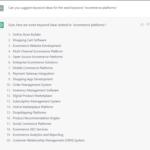
From here, you can filter out the keywords based on their business relevance and copy them into your keyword sheet.

“ChatGPT can provide you with some useful keyword suggestions based on your seed keyword, but it’s important to note that keyword research for your campaign will largely require a human touch. While ChatGPT can help you generate ideas, it’s not equipped to provide all the essential details you need to make informed decisions about which keywords to target. For instance, it won’t give you insights into search volume, traffic potential, ranking difficulty, or other critical factors that are crucial in determining the suitability of a keyword for your campaign. Therefore, it’s advisable to supplement ChatGPT’s suggestions with thorough human-driven keyword research to ensure you’re targeting the right keywords for your campaign’s success.”
Thus, ChatGPT can give you keyword ideas to initiate your research but can’t help you with thorough keyword research. For that, you need professional SEO tools like Ahrefs or Semrush. Bishal, Business Analyst
2. Compelling Titles
Writing a title that compels users to click through your link in search results takes time and effort. This is where you can put ChatGPT to use.
You can create multiple click-worthy titles for your topic in seconds with the help of ChatGPT.

“The ChatGPT prompt I use frequently is “Generate a list of blog post titles related to [topic]”. This is not the same as keyword research but can get your wheels turning in terms of possible blog post ideas. Similarly, ChatGPT can write or rewrite title tags for your articles.”
Example:
We want to write 10 click-worthy titles for the topic “how to make money online”.
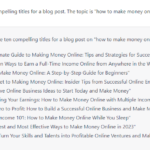
As you can see, the titles are quite attention-grabbing and have the right mix of power words, numbers, and creativity.
3. Content Outlines
Another use case for ChatGPT is creating content outlines for your chosen topic. Whether you have a title in mind or generate titles from ChatGPT as we did in the previous section, you can create a quick outline with this tool.

Another prompt I use quite often is “Write a blog post outline for an article titled [title]”. ChatGPT will provide the H1 and H2 headings, as well as the suggested sections and subject matter for each, which saves a ton of time when creating outlines for writers.
For instance, you liked title #2 from the list of 10 blog post titles we generated for “how to make money online”. And you want to write a 1500-word blog post on the same topic.
Here’s your outline:
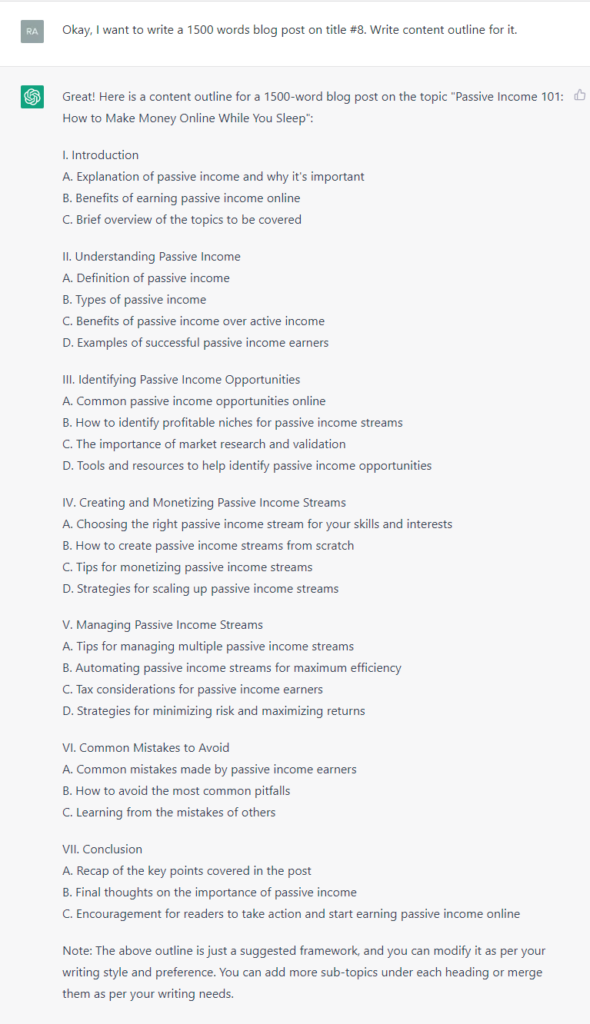
Considering that you want to write a 1500-word blog post, this outline is too comprehensive. So you may want to prioritise the main sections that are relevant to your title and trim down others.
4. Short-form Content Creation
You can create short-form content such as eCommerce product descriptions, meta descriptions, ad copies, social media posts, etc. at scale with ChatGPT. Moreover, you can also rewrite your existing short-form content and optimise them.
For our case, let’s create the meta description for the title we chose for the outline. We’ll ensure to specify instructions in the prompt to follow the SEO best practices while creating meta descriptions.
For example, it’s recommended to keep the meta description length under 160 characters and include the target keyword in it. So we specified these requirements in the prompt and got the three different meta descriptions to choose from.
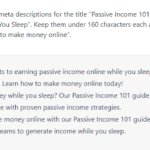
Similarly, you can also create multiple product descriptions for your eCommerce store and select the one that fits the best. Thus, you can scale up your content optimisation plan by automating certain SEO tasks with ChatGPT.
5. Search Intent Grouping
If you have a list of keywords and you want to classify them according to their search intent, you can use ChatGPT for the same. However, for this SEO use case, we’d advise you to use ChatGPT with a pinch of salt because search intent classification isn’t simply black and white.
For an accurate search intent classification, you need to analyse the SERPs, top-ranking results, and SERP features before you come to a conclusion.
But here’s how you can do a basic classification:
Let’s assign the search intent to keyword ideas we generated earlier in this post.
The prompt we used:
“Assign search intent for the above keywords and present in table format.”

Once you have this basic classification, you can perform search intent analysis based on the three C’s — content type, content format, and content angle — for top ranking pages.
6. Automation in Link-building Outreach
Link building is one of the most crucial — but time-consuming — tasks in SEO. You need to reach out to hundreds of websites every month to generate backlinks from high-authority sites.
You can automate certain parts of it with ChatGPT to speed up the process.

“ChatGPT can be used to create outreach emails that can be sent to other websites in your industry. By using natural language processing (NLP) technology, ChatGPT can help you create personalised outreach emails that are more likely to be read and responded to.”
For example, let’s say you’re a SaaS business operating out of Melbourne and you’ve developed a comprehensive SEO toolset. Now, you want to get a backlink to one of the tool pages from a leading SEO agency in Australia.
Now, let’s create an outreach email with ChatGPT to request the backlink.
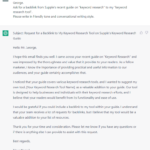
Not bad!
This was just an example, of course, the outreach email can be a lot better than this. For that, you have to play around with some prompts and see what gives you the most effective results.

“It is important to note that link building is a complex process that requires a strategic approach. While ChatGPT can be a helpful tool, it is not a replacement for a comprehensive link building strategy that includes other tactics such as guest posting, broken link building, and influencer outreach.”
7. Technical SEO Tasks
Next, there are quite a few technical SEO tasks that you can automate with ChatGPT. For instance, you can generate:
- Structured data,
- JavaScript code
- XML sitemaps
- RegEx for Google Search Console
- Hreflang tags, and more.
Let’s check how it generates XML sitemap data.
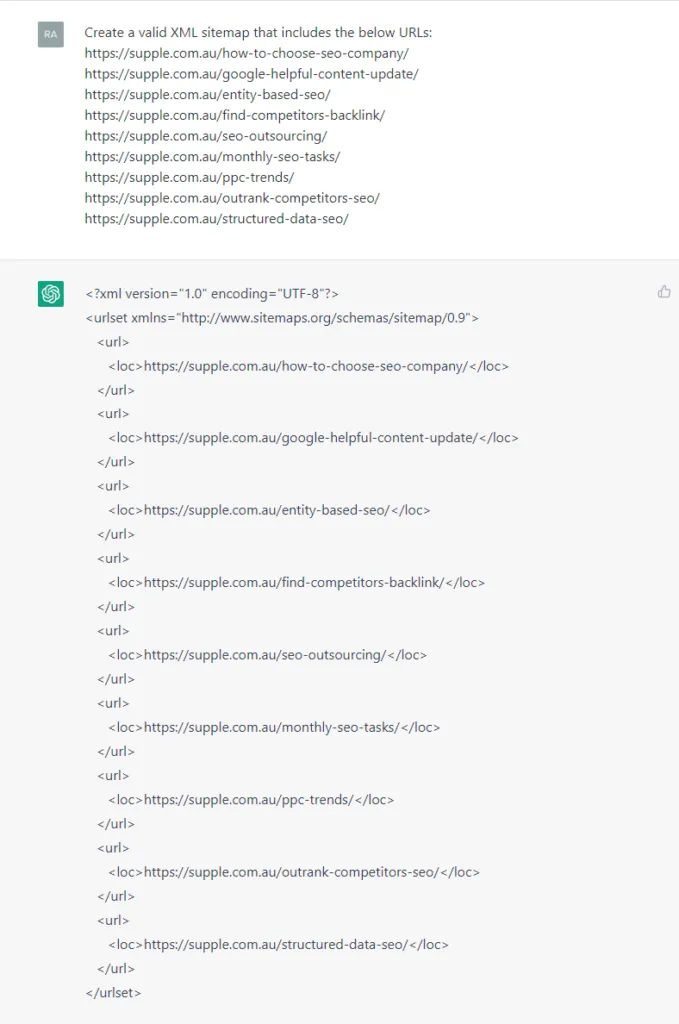
Similarly, you can use this tool for other technical SEO use cases too.

“As ChatGPT can assist in writing code, it can be used to write and structure code more efficiently to benefit site speed. However I think the responsibility to use ChatGPT in this way would sit more with developers rather than SEO professionals.”
8. Content Repurposing
Content repurposing is a great way to extend the reach and impact of your existing content by adapting it into new formats and targeting different audiences. ChatGPT can help you rewrite your existing content in different formats for different platforms.

“My favorite way to use ChatGPT is for repurposing content. You can give ChatGPT something original you’ve written, and simply ask it to reformat it for different platforms. For example, you can ask it to turn a LinkedIn post into a Twitter thread, or repurpose a podcast transcript into a blog in your own tone and style.”
Here’s an example:
We took a section from our blog post and asked ChatGPT to rewrite it for a LinkedIn post.
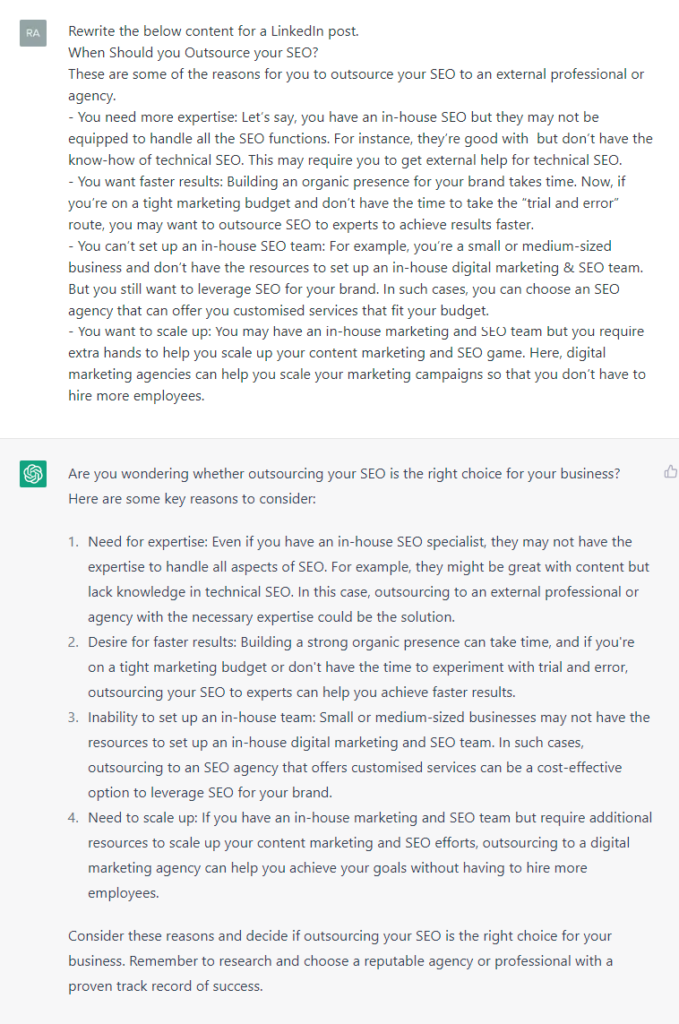
Likewise, you can repurpose your blog content into YouTube or Podcast scripts, and vice-versa.
9. Generate FAQs
Finally, you can also consider using ChatGPT for SEO FAQs.
Including FAQs in your website content can be helpful in multiple ways. First, it improves your user experience by providing brief answers to the most common questions on a subject. Secondly, when you create a well-thought FAQs section, it increases your chances of appearing in Google’s People Also Ask (or Answer Box) queries — provided you’ve optimised it with FAQs schema.
So, whether you want to create a standalone FAQs page or as a part of content, you can quickly discover these commonly asked questions with ChatGPT.
For instance, let’s pick one topic — “How to Make Money Online: A Step-by-Step Guide for Beginners” — from the list of titles we created earlier. And ask ChatGPT to generate FAQs for this post.

Although all these questions are relevant to the topic, conduct additional research with SEO tools to determine whether you’re targeting the right questions for FAQs.
Start Leveraging ChatGPT for SEO
There you have it.
ChatGPT is undoubtedly an impressive and useful tool for multiple applications. And, now that you know some of the SEO use cases of ChatGPT, you can start experimenting with it for your daily SEO tasks.
The above SEO use cases are non-exhaustive and there would be plenty more (and advanced) use cases of ChatGPT. Since it’s still an early stage for this tool and considering its limitations, make sure you double-check the work automated with the tool before making it live on your site.
At the same time, if you want our help in scaling your SEO strategy, feel free to book a consultation call with our SEO expert.
Frequently Asked Questions (FAQs)
Can you use ChatGPT for SEO?
Yes, you can use ChatGPT for SEO tasks like keyword suggestions, generating compelling titles and meta descriptions, creating content outlines, short-form content creation, and generating FAQs. You can save time and increase productivity by using ChatGPT for your SEO tasks. However, it is important to remember that ChatGPT should be used in conjunction with human analysis and judgment to ensure the best results.
How to use ChatGPT for digital marketing?
ChatGPT can be used for a variety of digital marketing tasks such as short-form content creation, email marketing, social media marketing, and PPC ads. For email marketing tasks, ChatGPT can be used to personalise subject lines, generate follow-up emails, etc. In social media marketing, ChatGPT can suggest captions & hashtags, and even generate content ideas. For PPC advertising, ChatGPT can help create ad copy and generate new keywords.
What is ChatGPT?
ChatGPT is a natural language processing model developed by OpenAI. It is a large language model that uses machine learning to generate human-like responses to text-based prompts. The model has been trained on a massive dataset of diverse texts, which allows it to generate coherent and contextually relevant responses to a wide range of inputs.
What are the drawbacks of ChatGPT?
One major drawback of ChatGPT is that it can produce biased or inappropriate responses if it is trained on biased or inappropriate data. It also lacks emotional intelligence and may struggle with nuanced or complex topics. Additionally, it is not yet capable of generating high-quality audio or visual content.
DIGITAL MARKETING FOR ALL OF AUSTRALIA
- SEO AgencyMelbourne
- SEO AgencySydney
- SEO AgencyBrisbane
- SEO AgencyAdelaide
- SEO AgencyPerth
- SEO AgencyCanberra
- SEO AgencyHobart
- SEO AgencyDarwin
- SEO AgencyGold Coast
- We work with all businesses across Australia
